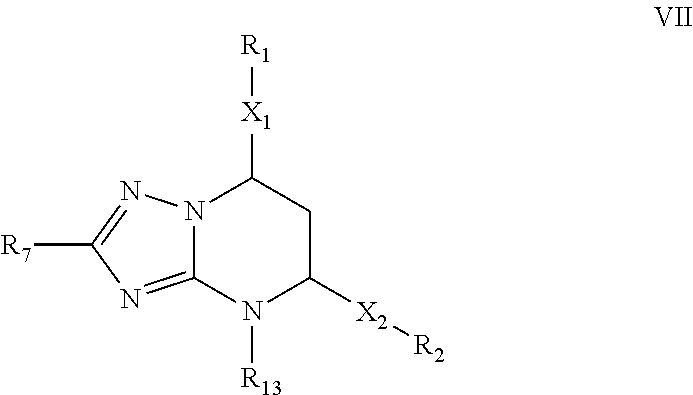Novel inhibitors of secretion of hepatitis b virus antigens
a technology of hepatitis b and antigen, which is applied in the field of compositions and methods for treating a hepatitis virus, can solve the problems of poor long-term response, debilitating side effects, and hepatitis b remains a major global health problem, and achieve the effect of reducing the serum level of hepatitis b surface antigen
- Summary
- Abstract
- Description
- Claims
- Application Information
AI Technical Summary
Benefits of technology
Problems solved by technology
Method used
Image
Examples
example 1
[0071]Synthesis of 7-(2-Chloro-6-fluorophenyl)-5-(4-chlorophenyl)-4,7-dihydro-[1,2,4]triazolo[1,5-a]pyrimidine. A solution of 1-(2-Chloro-6-fluoro-phenyl)-3-(4-chloro-phenyl)-propenone (5 mmol) and 3-amino-1,2,4-triazole (7.5 mmol) in DMF (5 mL) was refluxed for 2 h. The reaction mixture was cooled to room temperature, diluted with water (50 mL) and stirred sufficiently. The resulting mixture was filtered and washed with water to give the crude product, which was further purified either by recrystallization from EtOAc or through silica gel column chromatography (EtOAc / Hexanes 30:70) to afford the product as a white solid. Yield: 78%. m.p. 213-215° C. Rf=0.43 (EtOAc / Hexanes 50:50). MS: MH+=361. 1H NMR (300 MHz, DMSO-d6): δ 10.16 (s, 1H, NH), 7.66-7.61 (m, 3H, CHar), 7.49-7.21 (m, 5H, CHar), 6.81-6.80 (m, 1H, CH═C), 5.19 (s, 1H, CH). HPLC: 99.5% (Method B, tR=5.75 min).
[0072]The non-limiting compounds examples 2-16 were prepared according to the procedures described in Examples 1 abov...
example 2
[0073]5-(4-Chlorophenyl)-7-(2,6-dichlorophenyl)-4,7-dihydro-[1,2,4]triazolo[1,5-a]pyrimidine. Yield: 91%. m.p. 235° C. Rf=0.44 (EtOAc / Hexanes 50:50). MS: MH+=377. 1H NMR (300 MHz, DMSO-d6): δ 10.20 (s, 1H, NH), 7.65-7.35 (m, 8H, CHar), 7.06 (d, J=3.6 Hz, 1H, CH═C), 5.10 (dd, J=3.3, 1.5 Hz, 1H, CH). HPLC: 99.9% (Method B, tR=6.64 min).
example 3
[0074]5-(4-Chlorophenyl)-7-(2,6-difluorophenyl)-4,7-dihydro-[1,2,4]triazolo[1,5-a]pyrimidine. Yield: 83%. m.p. 223-224° C. Rf=0.40 (EtOAc / Hexanes 50:50). MS: MH+=345. 1H NMR (300 MHz, DMSO-d6): δ 10.13 (s, 1H, NH), 7.66-7.61 (m, 3H, CHar), 7.49-7.41 (m, 3H, CHar), 7.13-7.07 (m, 2H, CHar), 6.63 (d, J=3.6 Hz, 1H, CH═C), 5.26-5.25 (m, 1H, CH); 19F NMR (282 MHz, DMSO-d6): δ−118.26. 13C NMR (75 MHz, DMSO-d6): δ 160.6 (dd, JC-F=247.9, 7.7 Hz, C), 150.5 (C), 150.4 (C), 135.9 (C), 134.3 (C), 133.5 (CH), 131.4 (t, JC-F=10.7 Hz, C), 129.2 (CH), 128.4 (CH), 117.2 (t, J C—F=15.2 Hz, C), 112.8 (d, J C—F=24.9 Hz, CH), 95.1 (CH), 50.8 (CH). HPLC: 98.8% (Method B, tR=4.96 min).
PUM
| Property | Measurement | Unit |
|---|---|---|
| pH | aaaaa | aaaaa |
| pharmaceutical composition | aaaaa | aaaaa |
| composition | aaaaa | aaaaa |
Abstract
Description
Claims
Application Information
 Login to View More
Login to View More - R&D
- Intellectual Property
- Life Sciences
- Materials
- Tech Scout
- Unparalleled Data Quality
- Higher Quality Content
- 60% Fewer Hallucinations
Browse by: Latest US Patents, China's latest patents, Technical Efficacy Thesaurus, Application Domain, Technology Topic, Popular Technical Reports.
© 2025 PatSnap. All rights reserved.Legal|Privacy policy|Modern Slavery Act Transparency Statement|Sitemap|About US| Contact US: help@patsnap.com



